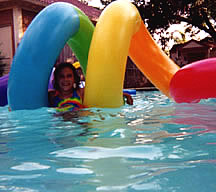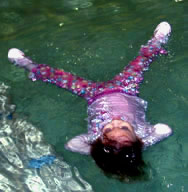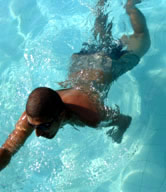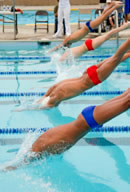Thomas J. Parr, M.D., F.A.C.S.
| ||||||
| WELCOME • ABOUT DR. PARR
• PATIENT INFO • en español SPORTS MEDICINE • ARTICLES/LINKS • CONTACT US • PAY YOUR BILL ONLINE |
||||||
|
||||||||
SwimmingYou are never too young or too old to learn to swim. Swimming is a fun recreational activity, a rewarding competitive sport, and a great form of exercise, appropriate for all ages. We have a variety of bodies of water in all of our neighborhoods, and we use water as a major form of recreation in this part of the country. Regardless of age or culture, in the United States it is important for everyone to know how to swim well enough and far enough to get him or herself out of trouble. Safe swimming actually does require more than just being able to do a little "dog paddling" around a swimming pool. It is important to know how to float, breathe, kick, and paddle efficiently enough to have a reasonable chance of surviving a water accident. While there is no such thing as "drown proofing" yourself or your child, there is swimming training available for all ages. I highly recommend that you make safe swimming a part of your family's regular sports activities. It is also important to know when additional safety measures need to be taken around the various bodies of waters that we have in Ft. Bend County and the Greater Houston and Galveston Areas. There is a tendency to think that because a child has floaties on his arms, he or she is safe in the water. Many professional swim instructors do not encourage the use of floaties. Such flotation devices cause children to lose their instinct to get back up to the surface of the water on their own, because they are learning from experience to just wait and they will automatically "pop back up." Also, children can slip out of them in a moment's time while an adult isn't watching. The same is true for other inflatables, such as pool toys, air mattresses, circular tubes, or noodles. The only truly safe floatation device is a certified life jacket, correctly fitted for the age and weight of each person. According to the Centers for Disease Control (CDC), "in 2005, there were 3,582 fatal unintentional drownings in the United States, averaging ten deaths per day." Drowning happens fast. A person can drown within two minutes after the head is under water, allowing very little time for rescue. Twenty-five percent (25%) of the fatal drownings were children ages 14 years and younger, and for each fatal drowning, there are four more who experienced near fatal drowning, resulting in permanent mental injuries, such as "memory problems, learning disabilities, and permanent loss of basic functioning (i.e., permanent vegetative state)." In some families, swimming historically has not been encouraged because ancestors came from areas where it was either too dangerous to be in natural bodies of water or where water was so precious that it primarily was used only for cooking and drinking. For others, the modern worldwide tendency of skimpy bathing suits is not in keeping with their cultures. Fortunately, a number of modern swimsuit fabrics now provide the ability to adapt to special cultural requirements and still not be an obstacle to swimming. Be certain your children never swim without a responsible adult closely watching. This adult should be prepared to go into the water to help a child on a moment's notice. This means that a weak adult swimmer needs to have a life jacket on and a rope readily available if he or she is the designated "responsible adult." When swimming in a public recreational area, a good family rule might be that the lifeguard must be on duty before your children may get into the water. In the Greater Houston Area, including Ft. Bend County, we are very fortunate to have a variety of locations where we can learn to swim. Call your local community parks department, the YMCA in your neighborhood, your neighborhood pool office, or a variety of private swim clubs in the area to find a swimming program that you and your family can enjoy. Some are only summertime facilities, and others are indoor pools, offering year-round instruction. The costs for lessons can range from nominal charges at public pools and not-for-profit organizations, such as a city parks department or the YMCA, to a little more at private facilities. If you have a pool in your own yard, you also can hire certified private swim instructors to teach you and your children at home. INFANT WATER SURVIVAL INSTRUCTION (6 Months through Preschool): At least one local swim club (Houston Swim Club) offers a "float test" for children in their program who are under the age of 5. This is designed to simulate a child's accidentally falling into a pool fully clothed, including shoes. The child should be able either to float for 5 minutes or to reach the side of the pool without any assistance or coaching. To pass, this must be demonstrated in three consecutive sessions. Over the years, a number of young children in our area have been found by parents "survival floating" in the pool, just waiting for an adult to come get them. (See the picture above.) This is a much better outcome than the alternative, and definitely makes the time and effort to provide this early training worthwhile. SWIMMING INSTRUCTION FOR AGES 5 TO 13: SWIM TEAMS: TEENAGE & ADULT INSTRUCTION: Teenagers who cannot swim well or cannot swim at all are at the age where their friends will be going swimming. Your teenagers won't want to be left out, and they won't want to have to admit they are not safe in the water. This might get them into a situation where they are in over their heads, literally. Teenagers who are not able to swim safely are able to join "adult" classes. If you are an adult and cannot swim, you should consider taking lessons for your own safety. Many pools will offer adult instruction if you ask. Not only is this important for you, it is important for those around you. Some of the drownings each year occur when someone goes in to save a person who is drowning. We then often lose both. SWIMMING WITH DISABILITIES: If you have concerns, discuss them with the instructors at your pool. They may be able to arrange private instruction for your disabled child for a very reasonable fee. Private instruction would have the advantage of tailoring each lesson specifically for your child's abilities and potential skills. If entering and exiting the pool is a problem for someone disabled, you might look for a pool (perhaps at a physical therapy center) that has a harness to lift someone into and out of the water. Another possible consideration would be a specially designed ramp and water wheel chair, such as the AquaTrek Wheel Chair and AquaTrek Pool Ramp, which are made specifically for swimming pools and spas. SAFE DIVING: It is best to jump into ponds or lakes feet first, and consider wearing "swim shoes" on your feet when doing so. The bottom may be hiding a number of surprises, such as broken glass, rusty cans, jagged rocks, or other forms of trash. SECURING BACK YARD & APARTMENT POOLS: Use creative measures to enhance the security of all outside doors in houses with small children and a private pool. In my own home, I installed throw bolts at the very top of the doors where my small grandchildren could not go outside without our knowledge. It worked. We've caught them several times trying to open a door to get outside. Outside pools should have a safety fence around them, with an automatically closing and latching gate. The gate latch should be above the reach of children. The fence should be at least 4 feet high, and not have any way for a small child to climb over or to squeeze through. There are many very attractive fences available for installation. Some are permanent, while others can be moved by adults when wanted. Proper fencing and gating are especially important in apartment complexes with community area pools. Report any safety issues to management immediately. If it isn't resolved rapidly, contact your city health code safety enforcement office to report the safety hazard. An additional protective device is a flotation device that can sound an alarm inside the house if there is movement of the surface water in a pool. WATER CONNECTED ILLNESSES: For the most part, simple precautions will take care of the problem. The chlorine, used in proper quantity for the amount of water in the swimming pool, will kill the bacteria that can make people ill, but it generally will take between an hour to several days to properly disinfect a contaminated pool. The warmer the water in the pool, the faster the chlorine or other disinfectant will evaporate. A well maintained pool will have the water tested daily, if not more often, to ensure the disinfectant and pH levels are correct. Avoid swimming when you are ill yourself, especially if you have a stomach or intestinal illness, as fecal matter in a swimming pool can spread disease to all others who may be in the water. It is for this reason that infants and toddlers are (or should be) required to be "double diapered" in swimming pools. When swimming in areas of natural water runoff, including salt water, avoid swallowing the water, as this water will likely contain bacteria from animal waste. In addition to gastrointestinal illnesses, ear, eye, and skin infections can be spread in the water. Shower or bathe after swimming, and use "swimmer's ear" over-the-counter drops to remove the water from ears after swimming. It is important to keep your tetanus vaccinations current if you plan to swim in lakes, rivers, or the ocean. If you cannot remember when you had your last tetanus shot, contact your doctor to see if you need to get another one. Wound infections that seem to have begun shortly after swimming in lakes, rivers, and the ocean should not be ignored. These include sores, blisters, puncture wounds and other breaks in the skin. Wounds can become infected with organisms such as Mycobacteria marinum and Vibrio vulnificus bacteria from contact with the warm coastal waters of the Gulf of Mexico. Problems with this type of bacteria are more likely to occur during the warmer months of May through October (similar to Hurricane Season). If you become ill a few hours to a few days after being exposed to these waters or if you develop redness and inflammation around a puncture wound, you should seek medical attention immediately. Delayed medical care could result in losing a limb or even in death. If your immune system is compromised or if you are pregnant, you ought to consult your physician about any special precautions you should follow to protect your health during swimming. You need to be especially careful about exposure to bacteria and viruses found in streams, rivers, and salt water while swimming. OTHER SAFETY CONSIDERATIONS: Do not swim in the dark, and do not swim when you can hear thunder. Because lightening is electricity, it is very dangerous around water. And if you hear thunder, you have lightening in the area, whether you can see it or not. When swimming at a water park, always make sure the lifeguard is on station, and pay attention to instructions. Only go down a water slide feet first and face up, and wait until the swimmer in front of you has cleared the area. If you are not a good swimmer, wear a life jacket. SWIMMING AT THE BEACH: Face the waves so you can see what is coming your way. You will be less likely to be knocked down and perhaps even pushed toward the ocean floor. If the water gets a little rough, get out. Stay close to shore and away from piers or jetties because rip currents often occur near such fixed objects in the water. Be on the lookout for rip currents (which are usually "muddy rivers" flowing away from the shore), and if the lifeguard tells you to get out of the water, do so immediately. According to the United States Lifesaving Association's website, "rip currents can occur at any beach with breaking waves, including the Great Lakes." The USLA believes that "rip currents account for over 80% of rescues performed by surf beach lifeguards." Rip currents are very dangerous and even good swimmers can get carried out from the shore before they have time to respond. If you do get caught in a rip current, swim parallel to the shore until the water stops pulling you out. If you cannot get back to shore, you will need to know how to tread water while waving for the lifeguard to come help you. This is why it is a good family rule to never swim at a beach where there is no lifeguard on duty. According to their website, "The United States Lifesaving Association has calculated the chance that a person will drown while attending a beach protected by USLA affiliated lifeguards at 1 in 18 million." Always use sunscreen and otherwise take precautions to avoid sunburn. Wear protective swim footwear because you could easily step on a sharp object in the sand. Avoid areas where there are jellyfish or Portuguese Man-of-Wars. These will have the appearance of bluish to purplish, almost transparent, umbrella-shaped blobs floating in the water, or stranded on a beach after the tide has gone out. You will not be able to see their long tentacles hanging below the water's surface. If you get stung, seek professional medical help immediately. BEACH WARNING FLAGS: Generally, a GREEN flag means the water is rather calm and there is little undertow. A YELLOW flag means the conditions of the surf require caution. There will be some undertow and the waves may become rather rough. Always assume you may not swim in the surf if the flags are RED, DOUBLE RED, or BLACK. These all indicate that the undertow and surf are dangerous. You also should assume that it is illegal to swim if the red or black flags are up. If you see a PURPLE or BLUE flag, you are being told that the waters contain dangerous marine animals, including jellyfish, stingrays or dangerous fish, such as sharks. A TRIANGULAR ORANGE flag is warning about an environmental air quality or water quality danger. Keep in mind that if no flags are flying on a public beach, it DOES NOT mean that the waters are safe. You still must exercise great caution when swimming in the ocean water. — Tom Parr, M.D. |
COMMON SPORTS INJURIES & SAFE PARTICIPATION
Baseball & Softball
SPORTS MEDICINE RECOGNITION
Recognized as one of the "Top Sports Medicine Orthopedic Surgeons in the USA" by Castle Connolly. Dr. Parr has been named as an "Outstanding Orthopedic Surgeon of Texas", as seen in SPORTS ILLUSTRATED.
SPEAKER'S PROGRAM:
|
|||||||
| 14090 Southwest Freeway #130 Sugar Land TX 77478 Phone: 281-491-7111 |
© Copyright 2009-2018 Thomas J. Parr, M.D. |





